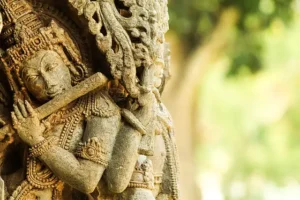
The holy Bhagavad Gita, the “Celestial Song of God” is the voice of the Lord himself giving the timeless teachings of Upanishads in the form of Yoga to Arjuna in the battlefield of Kurukshetra.
Also called Yoga Shastra, a scripture of Yoga science, and Shri Krishna as Yogeshwara (Lord of Yoga), Bhagavad Gita is a central text of Yoga. Shri Krishna taught the way of Yoga to a confused and disillusioned Arjuna facing a difficult situation of a battle with his teachers, kith, and kin. Over 18 chapters and 700 verses, Shri Krishna imparts profound yogic teachings that transcend time and resonate with seekers across race, creed, age, or religion.
Shri Krishna imparts three paths of Yoga for people of different temperaments – the paths of Karma Yoga (path of action), Bhakti Yoga (path of devotion), and Jnana Yoga (path of knowledge). These three paths are not exclusive of each other but harmoniously blend on the path to perfection.
Even a beginner on the path of Yoga can immensely benefit from the teachings of Bhagavad Gita.
Let us look at the definition of Yoga mentioned in Bhagavad Gita:
yoga-sthaḥ kuru karmāṇi saṅgaṁ tyaktvā dhanañjaya
siddhy-asiddhyoḥ samo bhūtvā samatvaṁ yoga uchyate || BG 2.48||
Perform actions dwelling in Yoga, abandoning attachment, O Arjuna, being alike to success and failure. Equanimity is called Yoga.
The nature of life in Prakriti is based on three gunas – sattva, rajas, and tamas. The three gunas by their dynamic forces create experiences that come in pairs of opposites. The mind tends to like something and dislike its opposite and thereby gets caught in a whirlpool of conflict and duality, attachment, and aversion. Yoga is samatvaṁ, the place of equanimity when both attachment and aversion to likes and dislikes are abandoned the mind finds peace and tranquility.
Our mind has become conditioned to categorize things into likes and dislikes the present-day culture even thinks of it as a strength and mark of self-identity. This misconception is the root of our miseries, anxieties, and delusions.
When we learn the path of non-attachment, our heart is purified and actions become an expression of inherent joy rising from our real Self.
In the Margaseersha month of the Hindu calendar, comes Gita Jayanti on the day of Shukla Ekadasi. This sacred day the message of the Bhagavad Gita was revealed by Shri Krishna to Arjuna. It is a perfect day to start the study of the Bhagavad Gita, or read one chapter and contemplate its meaning.
Also called Yoga Shastra, a scripture of Yoga science, and Shri Krishna as Yogeshwara (Lord of Yoga), Bhagavad Gita is a central text of Yoga. Shri Krishna taught the way of Yoga to a confused and disillusioned Arjuna facing a difficult situation of a battle with his teachers, kith, and kin. Over 18 chapters and 700 verses, Shri Krishna imparts profound yogic teachings that transcend time and resonate with seekers across race, creed, age, or religion.
Shri Krishna imparts three paths of Yoga for people of different temperaments – the paths of Karma Yoga (path of action), Bhakti Yoga (path of devotion), and Jnana Yoga (path of knowledge). These three paths are not exclusive of each other but harmoniously blend on the path to perfection.
Even a beginner on the path of Yoga can immensely benefit from the teachings of Bhagavad Gita.
Let us look at the definition of Yoga mentioned in Bhagavad Gita:
yoga-sthaḥ kuru karmāṇi saṅgaṁ tyaktvā dhanañjaya
siddhy-asiddhyoḥ samo bhūtvā samatvaṁ yoga uchyate || BG 2.48||
Perform actions dwelling in Yoga, abandoning attachment, O Arjuna, being alike to success and failure. Equanimity is called Yoga.
The nature of life in Prakriti is based on three gunas – sattva, rajas, and tamas. The three gunas by their dynamic forces create experiences that come in pairs of opposites. The mind tends to like something and dislike its opposite and thereby gets caught in a whirlpool of conflict and duality, attachment, and aversion. Yoga is samatvaṁ, the place of equanimity when both attachment and aversion to likes and dislikes are abandoned the mind finds peace and tranquility.
Our mind has become conditioned to categorize things into likes and dislikes the present-day culture even thinks of it as a strength and mark of self-identity. This misconception is the root of our miseries, anxieties, and delusions.
When we learn the path of non-attachment, our heart is purified and actions become an expression of inherent joy rising from our real Self.
In the Margaseersha month of the Hindu calendar, comes Gita Jayanti on the day of Shukla Ekadasi. This sacred day the message of the Bhagavad Gita was revealed by Shri Krishna to Arjuna. It is a perfect day to start the study of the Bhagavad Gita, or read one chapter and contemplate its meaning.











